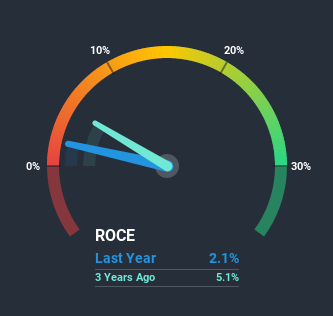Our Take On The Returns On Capital At Embry Holdings (HKG:1388)
If we want to find a potential multi-bagger, often there are underlying trends that can provide clues. Firstly, we'd want to identify a growing return on capital employed (ROCE) and then alongside that, an ever-increasing base of capital employed. If you see this, it typically means it's a company with a great business model and plenty of profitable reinvestment opportunities. However, after investigating Embry Holdings (HKG:1388), we don't think it's current trends fit the mold of a multi-bagger.
Understanding Return On Capital Employed (ROCE)
For those who don't know, ROCE is a measure of a company's yearly pre-tax profit (its return), relative to the capital employed in the business. Analysts use this formula to calculate it for Embry Holdings:
Return on Capital Employed = Earnings Before Interest and Tax (EBIT) ÷ (Total Assets - Current Liabilities)
0.021 = HK$61m ÷ (HK$3.3b - HK$429m) (Based on the trailing twelve months to June 2020).
Thus, Embry Holdings has an ROCE of 2.1%. Ultimately, that's a low return and it under-performs the Luxury industry average of 9.2%.
View our latest analysis for Embry Holdings

While the past is not representative of the future, it can be helpful to know how a company has performed historically, which is why we have this chart above. If you're interested in investigating Embry Holdings' past further, check out this free graph of past earnings, revenue and cash flow.
So How Is Embry Holdings' ROCE Trending?
In terms of Embry Holdings' historical ROCE movements, the trend isn't fantastic. Around five years ago the returns on capital were 13%, but since then they've fallen to 2.1%. And considering revenue has dropped while employing more capital, we'd be cautious. If this were to continue, you might be looking at a company that is trying to reinvest for growth but is actually losing market share since sales haven't increased.
What We Can Learn From Embry Holdings' ROCE
In summary, we're somewhat concerned by Embry Holdings' diminishing returns on increasing amounts of capital. Investors haven't taken kindly to these developments, since the stock has declined 66% from where it was five years ago. Unless there is a shift to a more positive trajectory in these metrics, we would look elsewhere.
One more thing: We've identified 2 warning signs with Embry Holdings (at least 1 which shouldn't be ignored) , and understanding these would certainly be useful.
While Embry Holdings may not currently earn the highest returns, we've compiled a list of companies that currently earn more than 25% return on equity. Check out this free list here.
When trading Embry Holdings or any other investment, use the platform considered by many to be the Professional's Gateway to the Worlds Market, Interactive Brokers. You get the lowest-cost* trading on stocks, options, futures, forex, bonds and funds worldwide from a single integrated account. Promoted
Valuation is complex, but we're here to simplify it.
Discover if Embry Holdings might be undervalued or overvalued with our detailed analysis, featuring fair value estimates, potential risks, dividends, insider trades, and its financial condition.
Access Free AnalysisThis article by Simply Wall St is general in nature. It does not constitute a recommendation to buy or sell any stock, and does not take account of your objectives, or your financial situation. We aim to bring you long-term focused analysis driven by fundamental data. Note that our analysis may not factor in the latest price-sensitive company announcements or qualitative material. Simply Wall St has no position in any stocks mentioned.
*Interactive Brokers Rated Lowest Cost Broker by StockBrokers.com Annual Online Review 2020
Have feedback on this article? Concerned about the content? Get in touch with us directly. Alternatively, email editorial-team (at) simplywallst.com.
About SEHK:1388
Embry Holdings
An investment holding company, designs, researches, develops, manufactures, trades in, and sells ladies brassieres, panties, swimwear, sleepwear, and others.
Adequate balance sheet and slightly overvalued.
Market Insights
Community Narratives



